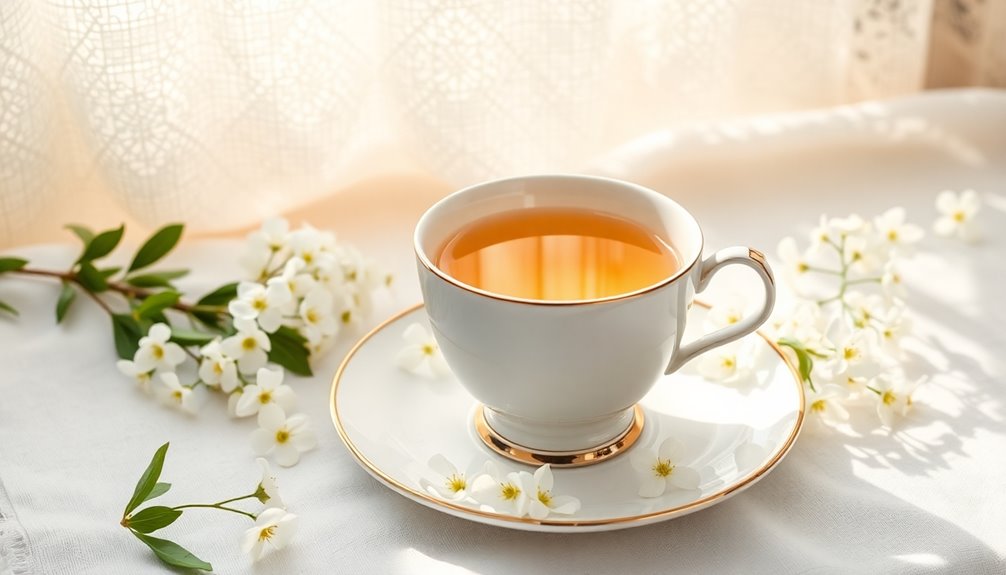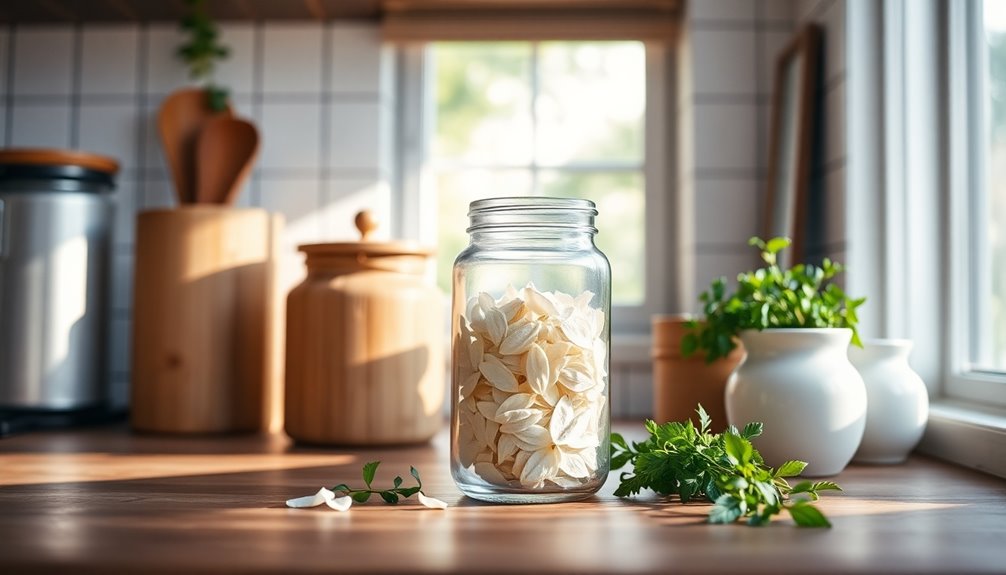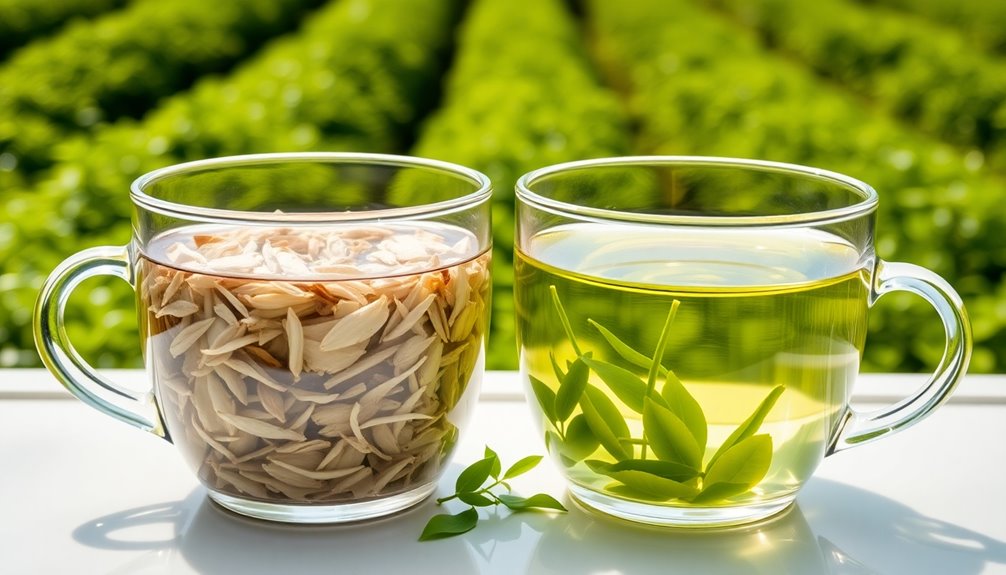White tea is the most delicate tea because it's made from young buds and leaves of the Camellia sinensis plant. The harvesting process is labor-intensive, requiring careful hand-picking during a short spring window. Since white tea undergoes minimal processing, it retains its fresh, subtle flavors. Gentle sun-drying and quick drying techniques prevent oxidation, which helps maintain its light taste. It's known for its pale yellow color, floral notes, and lower caffeine, making it enjoyable throughout the day. If you're curious about the different types and brewing methods, there's plenty more to discover!
Key Takeaways
- White tea is made from young buds and leaves, which are the most tender and delicate parts of the Camellia sinensis plant.
- Its minimal processing, involving hand-picking and gentle sun-drying, preserves its light and subtle flavors.
- The quick drying method prevents oxidation, maintaining the tea's delicate taste and natural characteristics.
- White tea has a gentle flavor profile with subtle floral and honey notes, enhancing its delicate nature.
- High-quality white tea varieties require specific harvesting conditions, making them rare and prized for their finesse.
Introduction
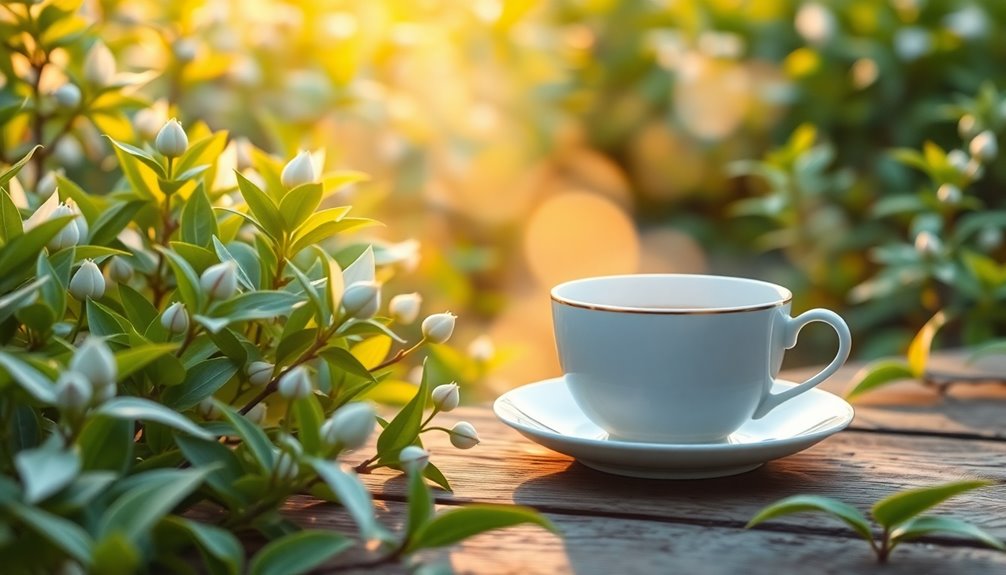
When it comes to the world of tea, delicacy is a hallmark of white tea, setting it apart from its more robust counterparts. You might be surprised to learn that white tea is made from the young buds and leaves of the Camellia sinensis plant. This makes it the least processed type of tea available. Its delicate nature comes from minimal processing, which means it undergoes very little oxidation. This helps preserve its fresh and subtle flavors.
The unopened buds are often silvery-white, covered in fine downy hairs, which signal their high quality. Harvesting white tea is no easy task; it's labor-intensive and requires picking during a specific window in spring when the buds are young. This ensures that the tea remains rare and delicate.
The gentle sun-drying process enhances its light and refreshing taste. That's why white tea stands out from more robust types like black and green tea.
If you're looking for a tea that embodies delicacy, white tea is your best bet. It offers a unique experience that's both soothing and flavorful, inviting you to savor every sip.
Delicate Processing Methods Involved

Although many teas undergo extensive processing, white tea stands out due to its gentle methods that preserve its natural essence. This rare tea is made primarily from young buds and immature leaves of the Camellia sinensis plant. You'll find that these delicate leaves are hand-picked during a short harvesting window of just 7 to 10 days each year.
The processing of white tea is all about care. Instead of rolling or crushing the leaves, which many other teas undergo, white tea relies on gentle techniques like sun drying or minimal steaming. This helps prevent oxidation and keeps the tea's light taste intact. By avoiding harsh processing methods, the tea retains its delicate flavor and natural qualities.
When you brew white tea, you'll notice its pale yellow hues, highlighting its gentle nature. The meticulous handling and quick drying processes make white tea not only unique but also one of the most sought-after teas around the world.
Minimal Oxidation Process
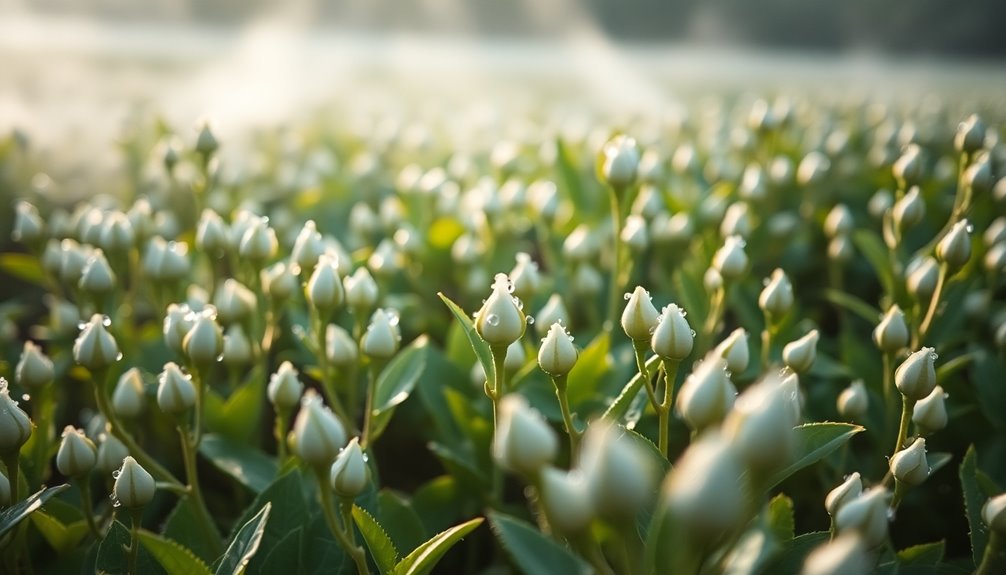
The minimal oxidation process of white tea is key to its unique flavor and delicate aroma. This special tea comes from the young leaves and buds of the Camellia sinensis plant, which means it's made with care.
Unlike black tea, which is fully oxidized, or green tea, which is quickly heated to stop oxidation, white tea undergoes minimal processing. The leaves are dried quickly, often in sunlight, to prevent wilting and oxidation.
This gentle approach helps preserve the tea's natural characteristics, resulting in a light and subtle taste. Because of this careful handling, white tea also has a high antioxidant content, particularly catechins, which are beneficial for your health.
The limited oxidation makes white tea one of the rarest and most sought-after teas in the world. It requires specific growing conditions and careful harvesting practices, which adds to its allure.
When you choose white tea, you're not just enjoying a beverage; you're experiencing a delicate treasure that showcases the beauty of nature. So, sit back, sip slowly, and appreciate the delicate flavors of this exquisite tea!
Flavor Profile of White Tea
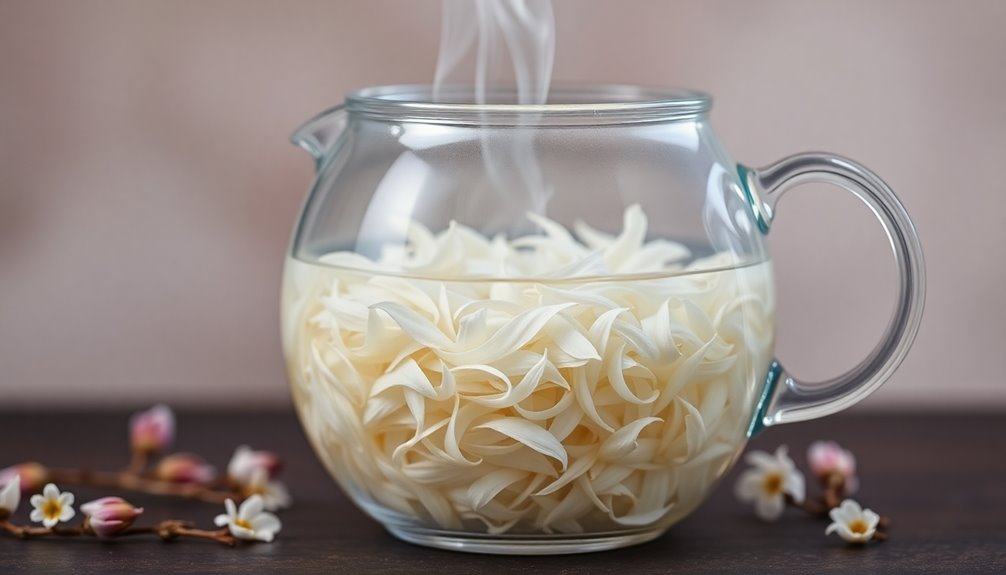
With its minimal oxidation process setting the stage, white tea offers a flavor profile that's as delicate as its appearance.
You'll find that white tea has a gentle taste, featuring subtle floral and honey notes that make each sip refreshing. The two most notable types—Bai Hao Yin Zhen (Silver Needle) and Bai Mudan (White Peony)—bring their own unique flavors. Silver Needle is sweeter and more delicate, while White Peony balances sweetness with vegetal hints.
To truly enjoy the delicate flavor profile of white tea, it's important to pay attention to the brewing temperature. Aim for 160-190°F (70-88°C) and steep your tea for 2-5 minutes. This ensures you capture the nuanced flavors without any bitterness.
Since white tea is low in caffeine, you can sip on it throughout the day without worry.
You'll appreciate how this tea can be enjoyed plain, letting its natural sweetness shine through.
Quality vs. Price Debate
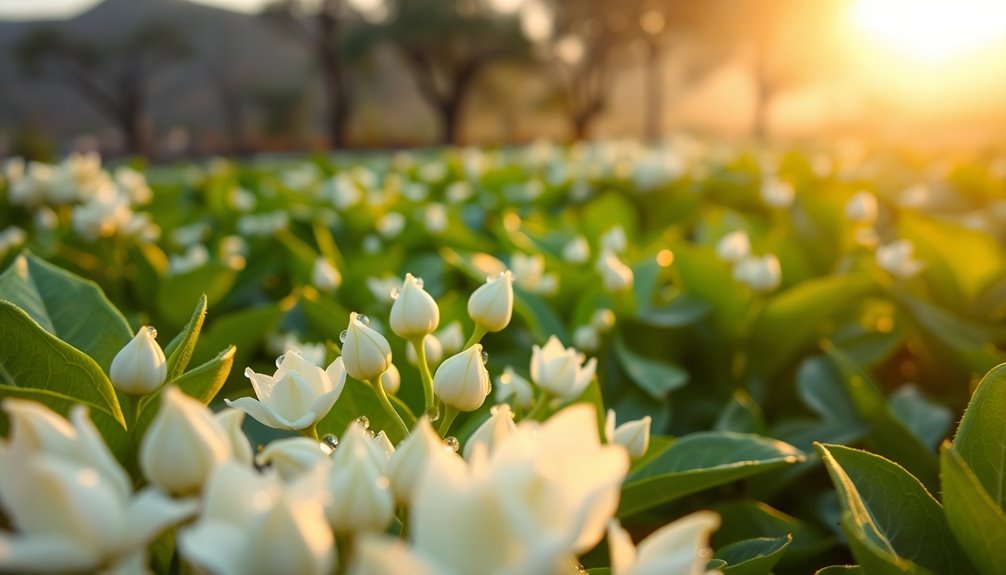
When considering the quality versus price debate of white tea, you'll quickly realize that the most exquisite varieties command a premium. For example, high-quality white tea like Bai Hao Yin Zhen, also known as Silver Needle, can cost between $18.50 to over $50 per ounce. This price reflects its rarity and the careful process of hand-picking young buds during a short spring window.
On the other hand, you can find more affordable options, like Shou Mei, ranging from $9.50 to $15.50 per ounce. However, these lower-grade teas often lack the delicate flavors and aromas that make premium varieties special.
Freshness plays a vital role, too. Reputable suppliers usually provide detailed processing information, showing their commitment to quality.
When you invest in high-quality white tea, you're not just paying for taste; you're also getting impressive health benefits. These teas are known for their high antioxidant levels, which add to their value.
Practical Applications

For tea enthusiasts looking to savor the unique qualities of white tea, understanding practical applications is essential.
White tea comes from the young leaves and buds of the Camellia sinensis tea plant, which gives it a delicate flavor. Because of its minimal processing, white tea retains its natural flavors and antioxidants, making it special among teas.
When brewing white tea, you'll want to pay attention to temperature. Use water heated to 160-185°F, and steep your tea for only 2-5 minutes. This short steeping time helps avoid bitterness and enhances the delicate taste.
You'll notice floral notes, subtle sweetness, and hints of honey and fruit in each sip.
Many tea connoisseurs prefer to enjoy white tea plain, allowing the exclusive flavors to shine without any additives. Since white tea is harvested only a few days a year, it's a rare treat that you can feel proud to share with friends.
Next time you brew a cup, take a moment to appreciate the care that goes into every sip and the delicate beauty of this exquisite tea.
Frequently Asked Questions
What Is the Most Delicate Tea?
When you explore delicate teas, you'll find that white tea stands out. Its young buds and minimal processing result in a light flavor profile, making it a gentle choice for your tea-drinking experience.
What Is Considered a Delicate Tea?
Delicate teas are those with minimal processing, preserving the natural flavors and aromas. You'll often find them light, sweet, and subtle, showcasing floral or fruity notes while brewing a pale, enticing color. Enjoy their gentle essence!
Is White Tea Better Than Other Teas?
You might find white tea better than other teas due to its subtle flavor, higher antioxidants, and lower caffeine content. Its unique varieties, like Silver Needle, offer delightful experiences that many tea lovers appreciate.
What Are the Side Effects of Drinking White Tea?
Drinking white tea can lead to side effects like insomnia, jitters, and stomach upset, especially if consumed excessively or on an empty stomach. It's wise to consult a doctor if you're pregnant or have health concerns.
Conclusion
In conclusion, white tea stands out as the most delicate tea due to its careful processing and minimal oxidation. Its light, sweet flavor makes it a treat for your taste buds. While it may come with a higher price tag, the quality often makes it worth it. So, whether you're sipping it for relaxation or enjoyment, white tea offers a unique experience. Give it a try, and you might just discover your new favorite drink!

